Profile in Preservation
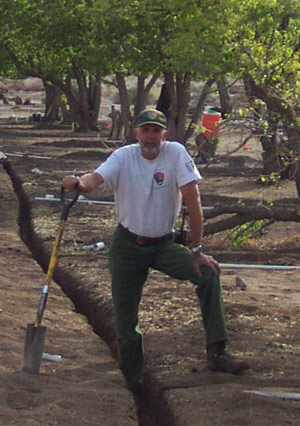
NPS Photo
QUICK FACTS
Position: Preservation Gardener and Arborist
NPS Start Date: 2004
Position Start Date: 2004
Special Skills: Tree surgery, tree rejuvenation, tree propagation
Associated Landscapes: Manzanar War Relocation Center, Manzanar National Historic Site
MEET GERRY ENES
Gerry Enes is a Preservation Gardener and Arborist who has worked for the NPS since 2004. He exudes a positive energy and would bring a great attitude to any job; at Manzanar, his efforts have been golden. Gerry joined the park just 12 years after its creation by President Bill Clinton.
He’s part of a small but dedicated team of staff at Manzanar National Historic Site that endures the harsh climate of the Owens Valley to preserve and interpret the nationally important landscape.
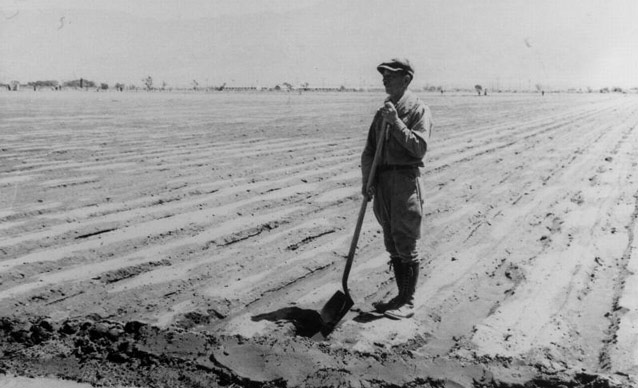
Photo by Francis Stewart, Japanese American Relocation Digital Archive, ca. 1942-43
Manzanar was the site of a War Relocation Center during World War II, where Japanese Americans were interned behind barbed wire for three years. Among the flimsy barracks buildings where they lived and worked, internees cultivated orchards and gardens. Orchard fruits augmented the camp meals, and Japanese-style gardens raised the spirits of internees who had been forced to relinquish their homes. Gerry cares for the historic vegetation remaining in the landscape, including more than 60 original fruit trees.
Gerry’s work day can vary from sub-freezing temperatures in January to an average high of 100 °F in the summer. In winter, Gerry prunes the fruit trees to remove dead and diseased wood, to stimulate new growth and re-shape the trees into more of their historic form.
During the growing season, Gerry keeps the trees watered and tries to stay one step ahead of pests. His nemeses include coyotes that bite into the water-saving drip-lines, Tule elk that nibble and rip at tree limbs, and ground squirrels that burrow into the root systems of the venerable trees.
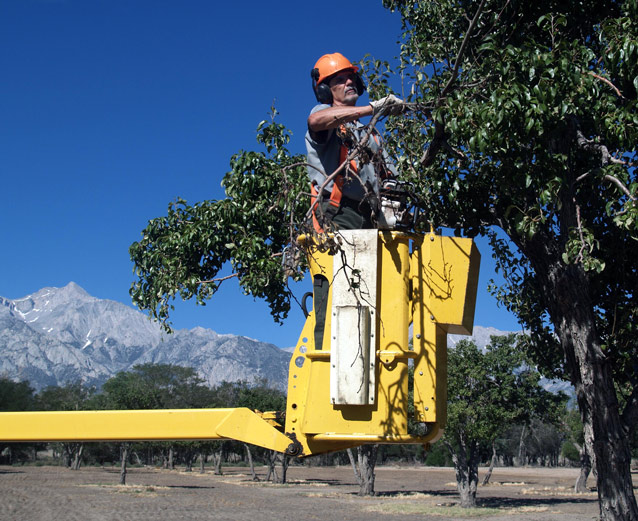
NPS Photo
Just recently, Gerry has replaced his ground squirrel traps with “Solar Mole Chasers” that deter small mammals by emitting a 400 Hertz intermittent signal. So far, the mole chasers seem to be doing the job, leaving Gerry more time to mow, weed, spray blighted trees with organic fungicide, and spread mulch. He’s established a nursery to propagate replacement trees with cuttings from the original trees. The cuttings are grafted onto the same hardy quince rootstocks used by the pioneer orchardists who originally planted the orchards. Gerry plants out the new trees to fill in the gaps of missing trees. Despite his heavy workload, he still finds time to talk with school children.
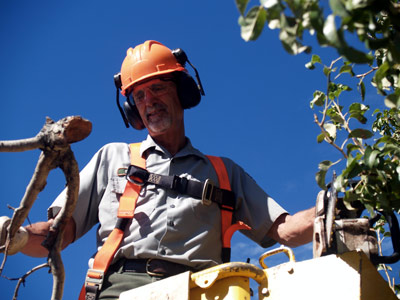
NPS Photo
In the 50 years after the internment camp was abandoned, the fruit trees had grown wild or been damaged by browsing wildlife. The surviving trees were nearly all pears. They’d been abandoned twice in the 20th century: once when the original pioneer orchardists sold their land to the City of Los Angeles to supply water to the Mulholland Viaduct, and again when the US Army’s War Relocation Authoriy closed the camp in 1945.
Gerry has followed in the footsteps of the Japanese-American internees in rescuing the trees from severe decline. He credits his greatest job satisfaction with “taking the fruit trees and bringing them back from the brink. They wouldn’t have lasted 10 more years. Now they’re flourishing, giving us loads of fruit.” Today, park visitors can help themselves to the fruit and take an interpretive tour of the orchards and camp landscape.
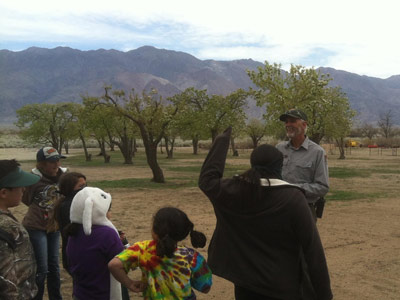
NPS Photo
When asked what he’s discovered since working at the park, Gerry says he’s learned so much more about the layers of history at Manzanar. He said before he worked for the park, “I’d driven by for 30 years, taking my kids camping in the Sierras. I knew about the camp, but I couldn’t remember where it was.” Nowadays he understands the history of the internment camp, the pioneer farmers and orchards that preceded the camp, and the story of the Paiute people that inhabited the Owens Valley for thousands of years.
Gerry sees history embedded in the landscape in projectile points, horseshoes, and the carefully arranged granite rocks of remnant Japanese Gardens. He says he often thinks about the internees while working on the old trees. “Learning about the history has been inspiring. When I’ve talked to internees I’ve been surprised by their lack of bitterness. Most were just kids at the time, and back then, that’s just the way it was. But after their release, the internees had to return and attempt to reestablish their lives. Most people don’t realize that happened.” Today, the park serves to raise awareness about a tragic period of American history.
With nine years of hard work behind him, Gerry should be very proud of his efforts to preserve the cultural landscape of Manzanar. He’s transformed the historic orchards from severely threatened to good condition, and has begun the work of restoring the orchards. The orchards are an integral part of the story of Manzanar, and with Gerry’s good care, their history lives on for all to experience.
Last updated: November 10, 2016
